Fermenting Beer with Fermentis SafAle S-33 Yeast
Published: July 29, 2025 at 7:35:23 AM UTC
Beer enthusiasts and brewers are always on the lookout for the ideal yeast strain. Fermentis SafAle S-33 stands out as a top choice. It's known for its versatility and reliability in fermenting a variety of beer styles. This yeast strain excels in fermenting a wide range of ales and lagers. It consistently delivers high-quality results. In this article, we'll explore the characteristics, usage, and applications of Fermentis SafAle S-33 yeast. We aim to provide brewers with valuable insights.
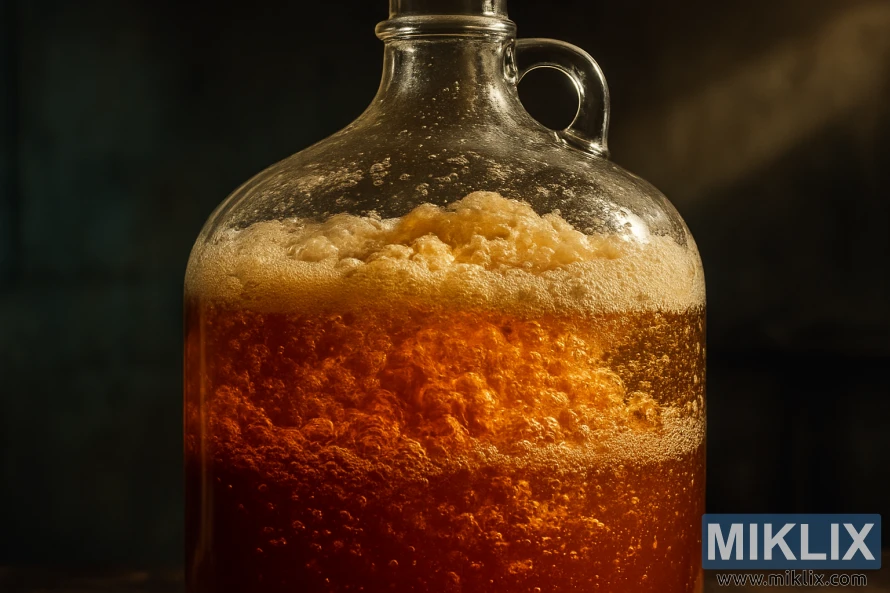
Key Takeaways
- Understanding the characteristics of Fermentis SafAle S-33 yeast
- Applications of S-33 yeast in various beer styles
- Tips for optimal fermentation with this yeast strain
- Benefits and challenges of using Fermentis SafAle S-33
- Best practices for brewing with S-33 yeast
Understanding Fermentis SafAle S-33 Basics
Fermentis, a leading yeast manufacturer, has developed SafAle S-33. This dry yeast strain is designed for ale fermentation. It's widely used in the brewing industry for its reliability and consistency in producing high-quality ales.
To grasp the basics of Fermentis SafAle S-33, understanding yeast strains and their role in beer fermentation is key. Yeast is a microorganism that consumes sugars in the wort, producing alcohol and carbon dioxide. The fermentation process is vital in shaping the beer's flavor, aroma, and character.
Ale yeast, like Fermentis SafAle S-33, ferments at warmer temperatures than lager yeast. This results in fruitier and more complex beers. SafAle S-33's characteristics make it suitable for various ale styles, providing brewers with flexibility and consistency.
- Reliable fermentation performance
- Produces complex and fruity flavors
- Suitable for various ale styles
- Easy to use dry yeast format
By understanding Fermentis SafAle S-33 and its role in brewing, brewers can better control fermentation. This leads to consistent and high-quality beer production.
Technical Specifications and Performance Metrics
For brewers aiming for the best fermentation results, grasping the technical specs and performance metrics of Fermentis SafAle S-33 is key. This yeast strain is celebrated for its strong performance and consistent outcomes. It's a favorite among brewers for these reasons.
The Fermentis SafAle S-33 yeast strain has a medium sedimentation rate and doesn't clump. This makes brewing easier. It also produces a powdery haze when added to beer. These traits enhance its reliability and ease of use in various beer fermentation tasks.
Regarding fermentation parameters, Fermentis SafAle S-33 is quite adaptable. Knowing the ideal temperature, pH, and oxygen levels is vital for its best performance. Its versatility in different conditions makes it ideal for a wide range of beer styles.
- Medium sedimentation rate for easier handling
- No clump formation for consistent rehydration
- Produces a powdery haze when resuspended
- Adaptable to various fermentation conditions
Understanding these technical details and performance metrics helps brewers fine-tune their fermentation processes. This knowledge aids in creating high-quality beers with the desired flavors and aromas. Fermentis SafAle S-33's dependability and performance make it a valuable asset in both commercial and homebrewing settings.
Optimal Temperature Range and Fermentation Conditions
To achieve the best fermentation results with Fermentis SafAle S-33, it's essential to control temperature and create a proper fermentation environment. The ideal temperature for Fermentis SafAle S-33 is between 18-26°C (64.4-78.8°F).
Keeping the temperature consistent within this range is key for healthy yeast growth and a successful fermentation. A good fermentation environment also means managing factors like nutrient availability and pH levels.
- Monitoring and adjusting temperature as needed to stay within the optimal range.
- Providing enough nutrients for yeast growth.
- Keeping the pH level suitable for fermentation.
By managing these factors, brewers can enhance Fermentis SafAle S-33's performance. This leads to the production of high-quality beer.
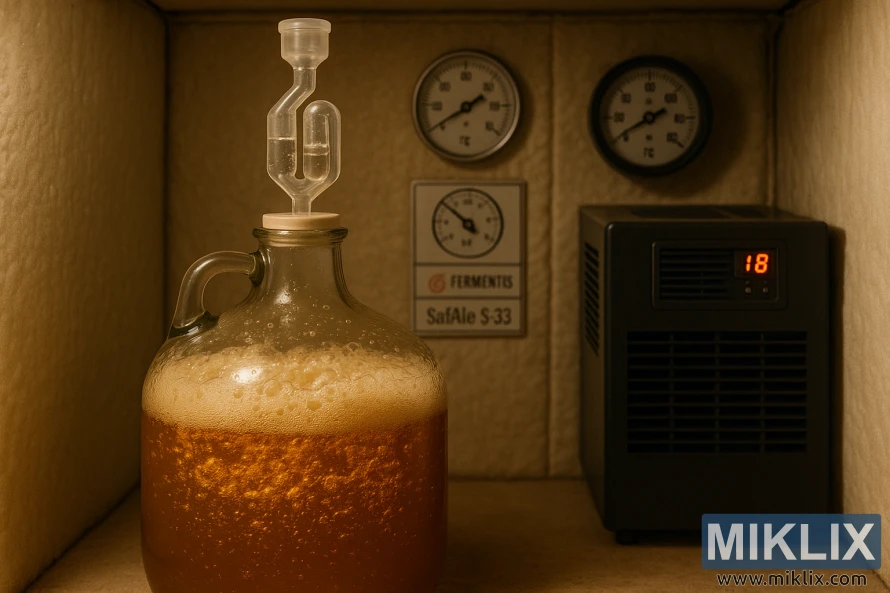
Suitable Beer Styles for SafAle S-33
Fermentis SafAle S-33 yeast is a versatile strain, suitable for a wide range of beer styles. Its high fermentation performance and adaptability make it perfect for brewers aiming to create complex and flavorful beers.
The SafAle S-33 yeast strain excels in fermenting Belgian ales, English ales, and New England IPAs. Its versatility in handling various fermentation temperatures and conditions makes it a favorite among brewers.
SafAle S-33 is known for its compatibility with a variety of grain types and hop varieties. This makes it an excellent choice for brewers eager to experiment with different beer styles and flavor profiles.
Key characteristics that make SafAle S-33 suitable for a wide range of beer styles include:
- High attenuation and alcohol tolerance
- Ability to ferment at a range of temperatures
- Neutral flavor profile, which allows the brewer to showcase the characteristics of the grain and hops
Understanding the characteristics of SafAle S-33 and its compatibility with different beer styles empowers brewers to create a wide range of delicious and complex beers.
Flavor Profile and Aromatic Characteristics
Fermentis SafAle S-33 yeast is celebrated for its unique flavor profile and aromatic traits. It imparts a fruity and estery taste, enriching the beer's mouthfeel and body.
The distinct flavor and aroma of Fermentis SafAle S-33 are key to its success. These yeast-derived elements significantly influence the beer's character.
- Fruity esters that enhance the beer's complexity
- Aromatic compounds that contribute to the beer's overall aroma
- A balanced flavor profile that complements various beer styles
The aromatic traits of Fermentis SafAle S-33 are equally noteworthy. It offers a subtle mix of yeast-derived flavors, adding depth and complexity to the beer.
Pitching Rates and Cell Viability
The success of Fermentis SafAle S-33 in beer fermentation depends on the right pitching rates and cell viability. Finding the perfect balance is essential for the best fermentation results.
The suggested pitching rate for Fermentis SafAle S-33 yeast is between 50-80 g/hl. This range supports a healthy fermentation process. It ensures the yeast can efficiently convert sugars into alcohol.
Fermentis SafAle S-33 has a high cell viability of >1.0 * 10^10 cfu/g. This high viability rate means more yeast cells are alive and ready to ferment. This contributes to a consistent and reliable fermentation process.
- Proper pitching rates help in avoiding under or over-pitching, both of which can lead to fermentation issues.
- High cell viability ensures that the yeast can handle the fermentation workload efficiently.
- Following the recommended pitching rates and leveraging the high cell viability of Fermentis SafAle S-33 can lead to improved fermentation outcomes and better beer quality.
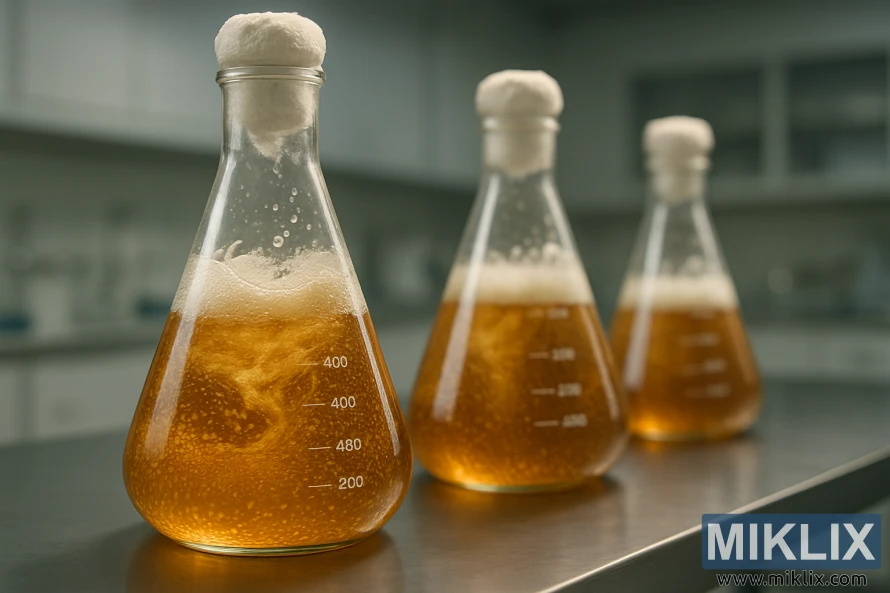
Fermentation Timeline and Stages
The fermentation timeline for Fermentis SafAle S-33 yeast is a critical component of the brewing process. Understanding the different stages of fermentation is essential for achieving the desired beer quality.
Fermentis SafAle S-33 has a medium sedimentation rate and forms no clumps, allowing for a smooth fermentation process. This characteristic is beneficial as it ensures that the yeast remains in suspension long enough to complete the fermentation process efficiently.
The fermentation process with Fermentis SafAle S-33 can be broken down into several stages: the lag phase, exponential growth phase, stationary phase, and attenuation phase. During the lag phase, the yeast adapts to the wort environment, and initial growth occurs.
- The exponential growth phase follows, where the yeast population increases rapidly, consuming sugars and producing alcohol and CO2.
- The stationary phase is characterized by a slowdown in yeast growth as the available nutrients are depleted.
- The attenuation phase is where the yeast continues to ferment the remaining sugars, leading to the desired alcohol content and flavor profile.
Monitoring these stages is critical for brewers to ensure the fermentation process proceeds as expected. Factors such as temperature control, pitching rates, and yeast viability play significant roles in the successful completion of the fermentation timeline.
By understanding and managing these factors, brewers can optimize the performance of Fermentis SafAle S-33 yeast. This results in high-quality beer with the desired characteristics.
Attenuation and Alcohol Tolerance
For brewers aiming at optimal fermentation, grasping the attenuation and alcohol tolerance of Fermentis SafAle S-33 is key. Attenuation is the yeast's skill in fermenting sugars, turning them into alcohol and carbon dioxide. Fermentis SafAle S-33 boasts an attenuation of 68-72%, showing its ability to fully ferment the wort. This results in a dry finish.
The alcohol tolerance of a yeast strain is vital in determining a beer's final ABV. Fermentis SafAle S-33 can handle alcohol levels up to 12% ABV. This makes it perfect for a broad range of beer styles, from session ales to stronger brews. Its tolerance ensures the yeast can finish fermentation, even in beers with higher alcohol content.
- High attenuation rate: 68-72%
- Alcohol tolerance: up to 12% ABV
- Suitable for various beer styles
Fermentis SafAle S-33's high attenuation and significant alcohol tolerance make it a versatile and dependable choice for brewers. By understanding these traits, brewers can better predict fermentation outcomes. This knowledge helps them make informed decisions about yeast strains for their beer recipes.
Comparing SafAle S-33 with Other Yeast Strains
Fermentis SafAle S-33 is a favorite among brewers, but how does it stack up against others? We'll examine its performance and characteristics against US-05 and WLP001. This comparison aims to highlight its strengths and weaknesses.
US-05 is celebrated for its clean fermentation and high attenuation. In contrast, SafAle S-33 brings a unique flavor profile with a more complex character. WLP001, known for its versatility, can produce a spectrum of flavors, from clean to complex.
Several factors influence yeast strain selection, including fermentation temperature, attenuation, and flocculation. Here's a quick comparison:
- SafAle S-33: Optimal temperature range between 64-75°F (18-24°C), attenuation around 80%, and moderate flocculation.
- US-05: Optimal temperature range between 65-75°F (18-24°C), attenuation around 85%, and high flocculation.
- WLP001: Optimal temperature range between 65-75°F (18-24°C), attenuation around 80%, and moderate flocculation.
Understanding these differences helps brewers choose the right yeast for their needs. Whether seeking a clean fermentation or a complex flavor, the right yeast is out there.
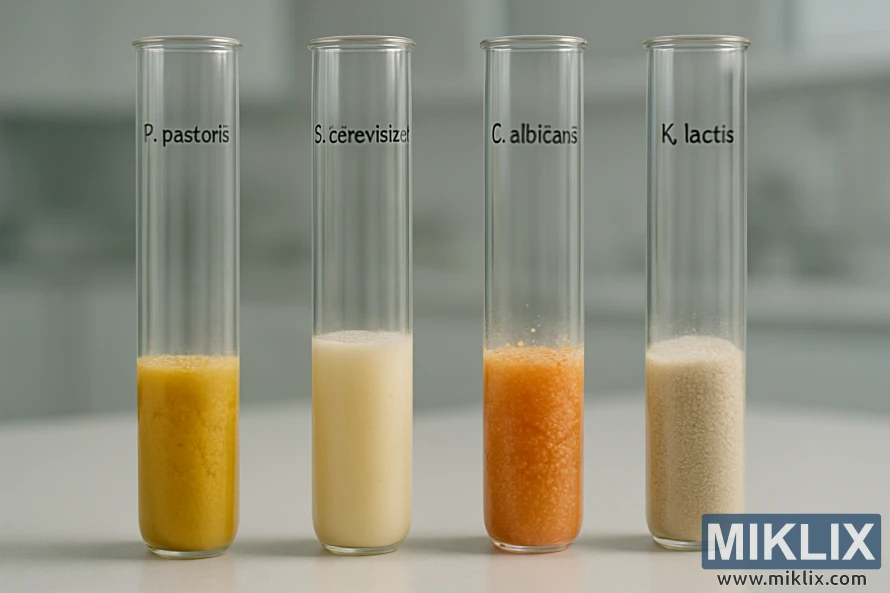
Storage and Handling Requirements
To keep Fermentis SafAle S-33 viable and effective, following recommended storage and handling is key. Proper storage conditions are vital for maintaining yeast quality.
Here are the key considerations for storing Fermentis SafAle S-33:
- Store in a cool, dry place, away from direct sunlight and moisture.
- Maintain a consistent refrigerated temperature between 4°C and 8°C (39°F to 46°F) if possible.
- Keep the yeast in its original packaging until use to protect it from contamination and exposure to air.
Correct handling of Fermentis SafAle S-33 is also essential for optimal fermentation results. This includes:
- Rehydrating the yeast according to the manufacturer's instructions to ensure proper cell viability.
- Avoiding exposure to extreme temperatures or sudden changes in temperature.
- Minimizing the time between rehydration and pitching to maintain yeast viability.
By following these storage and handling guidelines, brewers can maximize Fermentis SafAle S-33's benefits. This ensures a successful fermentation process and high-quality beer.
Common Troubleshooting Issues
When brewing with Fermentis SafAle S-33 yeast, several common issues may arise that can impact fermentation performance. Understanding these problems is key to achieving optimal results.
Some brewers may experience slow fermentation. This can be due to inadequate pitching rates, poor yeast viability, or suboptimal fermentation temperatures. Ensuring proper yeast rehydration and correct pitching rates can help mitigate this issue.
- Low attenuation can result from under-pitching or inadequate nutrient availability.
- Off-flavors can be caused by contamination, improper temperature control, or excessive stress on the yeast.
- Slow fermentation can be addressed by verifying the pitching rate, yeast health, and fermentation conditions.
To troubleshoot these issues, brewers should monitor fermentation conditions closely and adjust their techniques as needed. Regularly checking yeast viability and pitching rates can also help prevent problems.
By understanding the common issues associated with Fermentis SafAle S-33 yeast and taking steps to address them, brewers can achieve more consistent and successful fermentation outcomes.
Best Practices for Rehydration
The rehydration process for Fermentis SafAle S-33 is a critical step that can significantly impact fermentation outcomes. Proper handling and rehydration of the yeast are essential to ensure healthy fermentation and ultimately, high-quality beer.
To rehydrate Fermentis SafAle S-33, brewers can use either sterile water or boiled and hopped wort. The liquid should be at a temperature between 25-29°C (77-84°F) to facilitate optimal rehydration.
Here are some key considerations for rehydrating Fermentis SafAle S-33:
- Use a sufficient amount of liquid for rehydration to prevent shocking the yeast.
- Maintain the recommended temperature range to support yeast viability.
- Minimize exposure to air during rehydration to prevent oxidation.
- Gently stir the mixture to distribute the yeast evenly.
By following these best practices, brewers can help ensure that their Fermentis SafAle S-33 yeast is properly rehydrated. This leads to a healthy fermentation process and a high-quality final product.
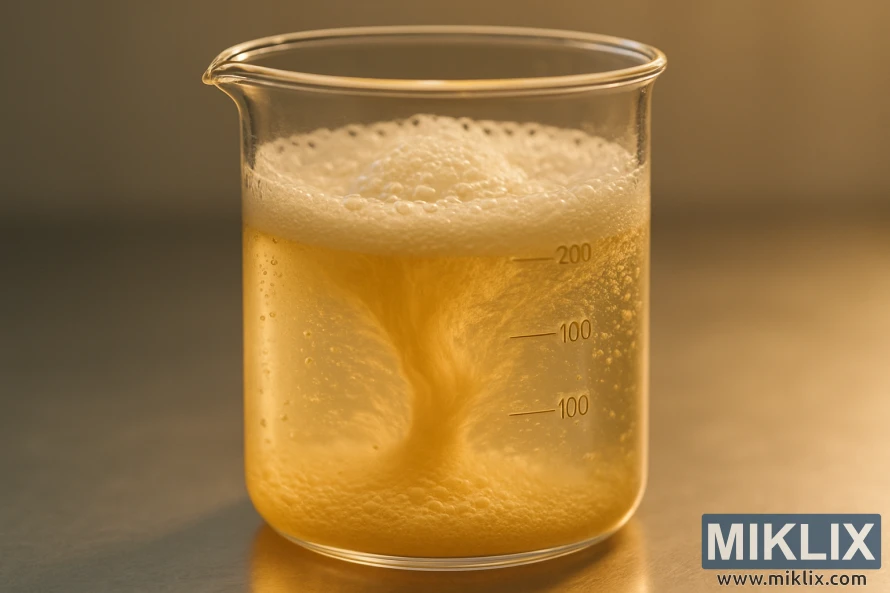
Tips for Achieving Maximum Performance
To get the most out of Fermentis SafAle S-33, brewers need to focus on fermentation details. It's essential to optimize fermentation conditions for the best results. This yeast strain is versatile and can benefit from careful attention.
Several factors are critical for optimal fermentation. Temperature, pH, and oxygen levels are key. The right temperature is vital. It impacts the yeast's performance and the beer's character.
Here are some tips for achieving maximum performance with Fermentis SafAle S-33:
- Monitor and control fermentation temperature to stay within the optimal range.
- Ensure proper pH levels to support healthy yeast activity.
- Adequately oxygenate the wort to promote vigorous fermentation.
- Use the correct pitching rate to avoid under or over-pitching.
By following these guidelines, brewers can optimize Fermentis SafAle S-33's performance. This leads to high-quality beers with consistent flavors.
Commercial Brewing Applications
Fermentis SafAle S-33 stands out for its versatility in commercial brewing. Its consistent performance is vital for large-scale fermentation. Even minor variations can significantly affect the final product.
In commercial brewing, managing yeast is key to maintaining quality and cutting costs. Fermentis SafAle S-33 is crafted to fulfill these needs. It provides a strong fermentation performance that brewers can count on.
Using Fermentis SafAle S-33 in commercial brewing offers several advantages:
- Consistent fermentation performance
- High attenuation and alcohol tolerance
- Easy yeast handling and management
To maximize yeast performance in commercial brewing, brewers should adhere to best practices. This includes proper rehydration, pitching rates, and monitoring fermentation. By following these steps, Fermentis SafAle S-33 will deliver high-quality beers that meet consumer demands.
In summary, Fermentis SafAle S-33 is a preferred yeast strain among commercial brewers. It offers a dependable and consistent fermentation performance. This is critical for large-scale brewing operations.
Homebrewing Success Stories and Tips
Homebrewers widely praise Fermentis SafAle S-33 for its fermentation prowess. This yeast has become a go-to for many due to its dependability and ability to craft beers with distinct flavors.
Its versatility stands out. Fermentis SafAle S-33 excels in brewing a variety of beer styles, from ales to lagers, and even some experimental brews. It has proven reliable in different fermentation conditions, appealing to both novices and seasoned brewers.
To get the most out of Fermentis SafAle S-33, homebrewers should prioritize proper rehydration and optimal fermentation temperatures. Here are some tips for maximizing yeast performance:
- Rehydrate the yeast according to the manufacturer's instructions to ensure optimal viability.
- Monitor fermentation temperatures to stay within the recommended range for SafAle S-33.
- Pitch the yeast at the correct rate to avoid under or over-pitching.
By adhering to these guidelines and utilizing Fermentis SafAle S-33's strengths, homebrewers can achieve fermentation success. They will produce high-quality beers that highlight the unique traits of this yeast strain.
Conclusion
Fermentis SafAle S-33 stands out as a high-performance yeast strain, essential for brewers aiming at optimal fermentation results. Its versatility makes it ideal for a broad spectrum of beer styles and fermentation conditions. This makes it a go-to choice for both homebrewers and commercial brewers alike.
This article has delved into the key aspects of SafAle S-33, including its technical specifications, optimal temperature range, and flavor profile. By grasping the fermentation process and how to effectively use this yeast, brewers can craft high-quality beers consistently.
In summary, Fermentis SafAle S-33 is a valuable asset for brewers seeking to enhance their beer's quality and consistency. By adhering to the guidelines and best practices discussed in this article, brewers can fully harness the capabilities of this yeast strain. This will lead to successful fermentation outcomes.
Further Reading
If you enjoyed this post, you may also like these suggestions:
- Fermenting Beer with Lallemand LalBrew BRY-97 Yeast
- Fermenting Beer with Mangrove Jack's M41 Belgian Ale Yeast
- Fermenting Beer with White Labs WLP802 Czech Budejovice Lager Yeast
